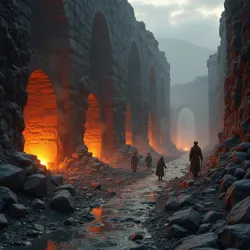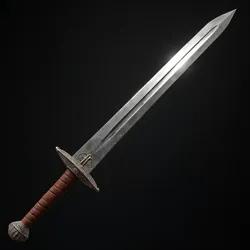Bulaqi Steel
Bulaqi steel, also known as Fulad-i Bulaqi (فولاد بولاقی) in Persian and Bulaqi Selek (булаки селек) in local Turkic dialects, refers to a high-quality steel produced in the region surrounding the city of Bulaq within 布拉齐斯坦 (Bùlāqísītǎn) during the 8th century and subsequent periods. Renowned throughout Eurasia for its exceptional strength, sharpness, and durability, Bulaqi steel became a highly sought-after commodity, playing a significant role in both military technology and economic exchange along the Silk Roads. The metallurgical expertise of Bulaq's artisans, combined with the unique mineral resources of the surrounding Lands of the Turquoise River, resulted in a steel that surpassed many of its contemporaries in quality and performance.
Origins and Production
The origins of Bulaqi steel production are deeply intertwined with the geographical and geological characteristics of 布拉齐斯坦. The region, situated at the foothills of the Tian Shan Mountains, was rich in mineral deposits, including iron ore and various alloying elements crucial for steelmaking. Local traditions suggest that the iron deposits in the vicinity of Bulaq, particularly in the Ironstone Hills just south of the city, were discovered and exploited from as early as the pre-Christian era. However, it was during the 7th and 8th centuries that the systematic and large-scale production of Bulaqi steel began to flourish, coinciding with the rise of Bulaq as a major urban and commercial center.
 Bulaq region at Tian Shan Mountains foothills rich in iron ore deposits.
Bulaq region at Tian Shan Mountains foothills rich in iron ore deposits.The process of producing Bulaqi steel was a complex and closely guarded secret, passed down through generations of artisan families. It involved a combination of traditional iron smelting techniques with innovative methods of carburization and refinement. The primary source of iron was locally mined ore, which was first processed in bloomery furnaces, common throughout Central Asia at the time. These furnaces, typically constructed from clay and stone, were fueled by charcoal and used forced air, often generated by bellows, to achieve the high temperatures necessary for reducing iron oxide into metallic iron.
The resulting iron from these bloomery furnaces was not steel but rather wrought iron, which is relatively soft and contains a low amount of carbon. To transform wrought iron into the highly valued Bulaqi steel, a process of carburization was essential. Artisans in Bulaq developed a unique method involving crucible steel production, a technique that was advanced for its time. Wrought iron pieces were placed in clay crucibles along with carefully selected organic materials, such as specific types of wood charcoal, bone, and certain leaves, which were rich in carbon. These crucibles were then sealed and heated in specialized furnaces for extended periods, sometimes days or even weeks, at carefully controlled temperatures.
This prolonged heating in a carbon-rich environment allowed the wrought iron to absorb carbon, transforming it into steel. The specific organic materials used and the precise temperature control during this process were key factors in achieving the unique properties of Bulaqi steel. The artisans of Bulaq were masters of this craft, able to judge the optimal duration and temperature by observing the color of the heated crucibles and through generations of accumulated empirical knowledge. After the carburization process, the crucibles were slowly cooled, and the resulting steel ingots were carefully extracted. These ingots then underwent further forging and shaping to create the final products, such as swords, daggers, armor plates, and tools.
Metallurgical Techniques of Bulaq
The distinctive qualities of Bulaqi steel were not solely attributable to the raw materials but also to the advanced metallurgical techniques employed in its production. While detailed written records from the 8th century are scarce, later accounts and archaeological findings offer insights into these methods. It is believed that Bulaqi steel production involved a sophisticated understanding of heat treatment, alloying, and forging.
Carburization Process
As mentioned, the carburization process was central to Bulaqi steel production. The use of crucibles allowed for a more controlled and even absorption of carbon into the iron compared to earlier methods like pack-carburization, which was common in other regions. The specific types of charcoal and organic materials used likely contributed to the steel's unique composition and properties. Some scholars speculate that specific minerals found in the River Turquoise watershed might have been added to the crucibles, intentionally or unintentionally, further influencing the steel's characteristics.
Alloying Elements
While primarily a high-carbon steel, Bulaqi steel likely contained trace amounts of other alloying elements that enhanced its properties. The iron ore from the Ironstone Hills might have naturally contained small quantities of elements like vanadium, molybdenum, or manganese. These elements, even in minute amounts, can significantly improve the strength, toughness, and heat resistance of steel. Artisans may have also intentionally added certain minerals or materials known to impart desirable qualities to the steel, although direct evidence of this from the 8th century is lacking.
Forging and Tempering
The forging process was crucial for shaping the steel and further refining its microstructure. Bulaqi smiths were renowned for their skill in forging, employing techniques such as pattern welding and differential hardening. Pattern welding involved layering and forging together different types of steel and iron to create intricate patterns and enhance the material's overall strength and flexibility. Differential hardening, a sophisticated heat treatment technique, allowed for different parts of a blade, for example, to have varying hardness. The edge could be hardened to maximize sharpness and edge retention, while the spine was left softer and more flexible to absorb shocks and prevent breakage. This technique was particularly important for swords intended for combat, balancing sharpness with resilience.
The final step in the production process was tempering, a heat treatment that reduces brittleness and increases toughness in hardened steel. Precise tempering was essential to achieve the desired balance of hardness and ductility in Bulaqi steel weapons and tools. The knowledge of these sophisticated metallurgical techniques, refined over generations, distinguished Bulaqi steel from ordinary iron and steel of the era.
Properties and Qualities
Bulaqi steel was celebrated for a combination of exceptional properties that made it superior to many contemporary steels. These qualities were frequently lauded in historical texts, poems, and travelogues from across Eurasia, contributing to the steel's legendary reputation.
Strength and Hardness
The most prominent characteristic of Bulaqi steel was its remarkable strength and hardness. Swords and blades crafted from this steel were said to be able to cleave through lesser metals and maintain their sharpness even after prolonged use and repeated impacts. This hardness was achieved through the high carbon content and the meticulous carburization and hardening processes employed by Bulaqi artisans. The steel's ability to retain a keen edge made it particularly prized for weaponry, giving warriors who wielded Bulaqi steel blades a distinct advantage in combat.
Sharpness and Edge Retention
Closely related to its hardness was Bulaqi steel's exceptional sharpness and edge retention. A well-crafted Bulaqi steel blade could be honed to an incredibly fine edge, capable of easily cutting through various materials, from textiles and leather to wood and even other metals. More importantly, this edge would last for a long time, requiring less frequent sharpening compared to blades made from inferior steels. This edge retention was crucial in battle, where a warrior needed a reliable weapon that would not dull quickly during prolonged engagements.
Durability and Flexibility
Despite its hardness, Bulaqi steel was not brittle. It possessed a degree of flexibility and toughness that prevented it from snapping or shattering under stress. This balance of hardness and ductility was a hallmark of high-quality steel and was particularly well-achieved in Bulaqi steel. The controlled forging and tempering processes played a key role in imparting this durability, ensuring that Bulaqi steel weapons could withstand the rigors of combat and maintain their structural integrity over time. This resilience was essential for weapons like swords and armor, which were subjected to significant forces during use.
Corrosion Resistance
While not stainless steel in the modern sense, Bulaqi steel was reported to have a degree of resistance to corrosion, particularly compared to other contemporary iron and steels. This property was likely due to the specific composition of the steel and perhaps the presence of trace alloying elements that formed a protective oxide layer on the surface. This corrosion resistance was a significant advantage, especially in the diverse climates encountered along the Silk Roads, where weapons and tools were exposed to varying levels of humidity and environmental conditions. The ability to resist rust and degradation contributed to the longevity and value of Bulaqi steel artifacts.
Aesthetic Qualities
Beyond its functional properties, Bulaqi steel also possessed aesthetic qualities that contributed to its allure. Pattern-welded blades, in particular, exhibited beautiful and intricate patterns on their surfaces, created by the layering and forging of different metals. These patterns were not merely decorative; they also reflected the complex craftsmanship and the inherent quality of the material. The visual appeal of Bulaqi steel weapons and artifacts further enhanced their prestige and desirability, making them status symbols as well as effective tools and weapons.
Uses and Applications
The exceptional qualities of Bulaqi steel led to its widespread use in various applications across 8th century 布拉齐ستان and beyond. Its primary and most celebrated use was in the production of weaponry, particularly swords and armor, but it also found application in tools and other specialized items.
 Bulaqi steel sword demonstrating its exceptional sharpness and strength.
Bulaqi steel sword demonstrating its exceptional sharpness and strength.Weaponry
Bulaqi steel was most famously used for crafting high-quality swords, daggers, and other bladed weapons. These weapons were highly prized by warriors and military leaders across Eurasia. The strength, sharpness, and durability of Bulaqi steel blades gave their wielders a significant advantage in combat. Swords made from Bulaqi steel were not only effective weapons but also symbols of status and prestige, often adorned with elaborate hilts and scabbards, reflecting the wealth and power of their owners.
The armies of 布拉齐ستان, including those of Khuttal under Queen Saman-banu and Bukhara under rulers who employed generals like Tarkhan Nizak, likely utilized Bulaqi steel weapons. The effectiveness of these armies in defending their territories against powerful empires like the Umayyad Caliphate and the Tang Dynasty may have been partly attributed to the superior quality of their arms. The Battle of the Iron Pass, where Queen Saman-banu's forces decisively defeated a Caliphal army, could well have seen Bulaqi steel blades in action.
Bulaqi steel was also used to produce armor, particularly plate armor and helmet components. While complete plate armor was not yet common in the 8th century, hardened steel plates were used to reinforce lamellar armor or to create helmets that offered superior protection compared to those made from iron or bronze. The durability of Bulaqi steel made it ideal for withstanding blows from weapons, providing better defense for warriors in the field.
Tools and Implements
Beyond weaponry, Bulaqi steel was also employed in the production of high-quality tools and implements. Its hardness and edge retention made it suitable for crafting tools that needed to maintain a sharp edge for prolonged use, such as axes, chisels, knives, and agricultural implements. These tools were valued by artisans, craftsmen, and farmers for their efficiency and longevity. The use of Bulaqi steel in tools contributed to improved productivity and craftsmanship in various sectors of the 布拉齐ستان economy.
Trade and Distribution
The high demand for Bulaqi steel led to its extensive trade and distribution along the Silk Roads. Merchants from Bulaq, such as Vasudev Seth, played a crucial role in transporting and marketing Bulaqi steel and finished goods made from it to distant markets. Caravans laden with Bulaqi steel products traversed the trade routes, reaching destinations as far west as Baghdad and as far east as Chang'an.
Bulaqi steel was traded in various forms: as raw ingots, as semi-finished blades and armor components, and as finished products like swords, daggers, and tools. It was exchanged for other valuable commodities, including silk, spices, precious stones, textiles, and horses. The trade in Bulaqi steel contributed significantly to the economic prosperity of Bulaq and the wider 布拉齐ستان region, making it a vital hub in the Eurasian trade network.
The reputation of Bulaqi steel spread far and wide, reaching the courts of powerful rulers and the workshops of skilled artisans across the continent. It became a benchmark for high-quality steel, and its name became synonymous with excellence in metallurgy. The demand for Bulaqi steel fueled further development of its production techniques and ensured its continued importance in trade and technology for centuries to come.
Cultural Significance and Legacy
Bulaqi steel transcended its material value to become a symbol of cultural identity and technological prowess for 布拉齐ستان. Its legendary qualities were celebrated in local folklore, poetry, and historical chronicles. The artisans who produced it were held in high esteem, and the city of Bulaq itself gained renown as a center of metallurgical excellence.
 Caravans transporting Bulaqi steel along the Silk Roads trade network.
Caravans transporting Bulaqi steel along the Silk Roads trade network.Symbol of Craftsmanship
Bulaqi steel became a potent symbol of the skilled craftsmanship and technological innovation of the people of 布拉齐ستان. The intricate production process, the closely guarded secrets of its making, and the exceptional qualities of the final product all contributed to an aura of mystique and admiration. Bulaqi steel artifacts were not merely utilitarian objects; they were testaments to human ingenuity and artistry, reflecting the cultural sophistication of their creators.
Military Prowess
The association of Bulaqi steel with superior weaponry linked it to military strength and martial valor. Warriors who wielded Bulaqi steel blades were seen as formidable and well-equipped. The use of Bulaqi steel weapons by the armies of 布拉齐ستان in successful defenses against powerful empires reinforced this association, contributing to a sense of regional pride and identity. Bulaqi steel became emblematic of the region's ability to defend itself and maintain its independence in a turbulent era.
Economic Prosperity
The trade in Bulaqi steel generated significant wealth for 布拉齐ستان, fostering economic growth and urban development. The city of Bulaq flourished as a major trading center, attracting merchants and artisans from distant lands. The economic benefits derived from Bulaqi steel production and trade contributed to the region's cultural vibrancy and its ability to support intellectual and artistic endeavors.
Lasting Impact
The legacy of Bulaqi steel extends beyond the 8th century. The techniques and traditions of Bulaqi steel production continued to influence metallurgy in Central Asia and surrounding regions for centuries. While the precise methods of 8th century Bulaqi steel production may have been modified and adapted over time, the pursuit of high-quality steel and the reputation of Bulaq as a center of metallurgy persisted. Even in later periods, steel from the Bulaq region was often associated with exceptional quality, indicating the enduring impact of its early metallurgical achievements.
The study of Bulaqi steel provides valuable insights into the technological capabilities and cultural dynamism of 8th century 布拉齐ستان. It highlights the region's role not only as a crossroads of trade and cultural exchange but also as a center of innovation and production, contributing significantly to the technological and economic landscape of Eurasia. The enduring fame of Bulaqi steel serves as a reminder of the ingenuity and skill of the artisans of 布лакистан and their lasting contribution to the history of metallurgy.
Table: Properties Comparison of Steels (Hypothetical)
Note: This table provides a hypothetical comparison based on historical accounts and general understanding of 8th-century metallurgy. Precise data for Bulaqi steel and contemporary steels is limited.
This table is intended to illustrate the relative advantages of Bulaqi steel as perceived in its time, particularly in comparison to other contemporary materials. It highlights the exceptional combination of properties that made Bulaqi steel so highly valued and sought after. The "Production Complexity" and "Cost" rows also indicate why Bulaqi steel was a luxury commodity, not a mass-produced material, further contributing to its prestige and exclusivity.
The continued study and appreciation of Bulaqi steel offer a window into the technological and cultural achievements of 8th century 布лакистан, a region that played a vital role in the interconnected world of the Silk Roads. Its legacy resonates in the annals of metallurgical history and in the cultural memory of Central Asia, a testament to the enduring power of human innovation and craftsmanship.